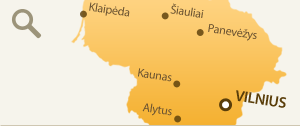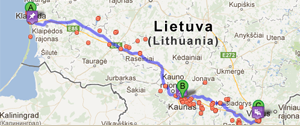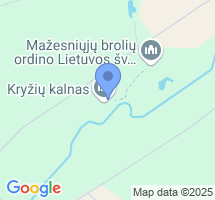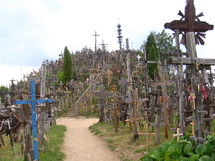The Hill of Crosses
The Hill of Crosses is a historical and architectural monument, a unique ensemble of folk art. Its peace, spirituality, authenticity, and sacred nature attracts visitors. The oblong mound, somewhat similar to a saddle, stands on a plain and is surrounded by the valleys of Kulpė stream and its nameless tributary. The hill itself sits on the Jurgaičiai-Domantai mound with a former ancient village dating back to the 13th-14th centuries. It became a sacred site in the 19th century. It is said that the first crosses were erected here by the next-of-kin of the rebels that fell in the 1831 rebellion. The family members erected the crosses at this site because the Tsarist reign did not allow them to pay proper tribute to the graves of their relatives. Even more crosses were put up after the rebellion of 1863. At that time, the tradition of visiting and erecting crosses on the hill began to emerge. The Hill of Crosses became a place of vow making. According to another version, many crosses were put up after the Virgin Mary and baby Jesus appeared on the mound in the 7th decade of the 19th century; it was she who supposedly encouraged people to put crosses at this place. In 1850, there were 17 crosses on the hill, from 1895 to 1898 the number increased to 180, and in 1938 there were over 400 crosses. The number of crosses also grew during the period of Soviet occupation; in 1960, there were 2,500 large crosses alone.
In the beginning of the 20th century, the hill was already quite well known. It was being visited by a lot of people, and services and feasts were taking place here. The Soviet government was not happy about the hill and its crosses. Thus, the "demolition" period, which lasted for almost 20 years, started. In 1958, the collective farm Meškuičiai began digging gravel on the Hill of Crosses. In 1961, the hill was surrounded by bulldozers. Wooden crosses were damaged or burnt, metal crosses were taken to the scrap dump, and stone and concrete crosses were smashed, buried or thrown into Kulpė Stream. Every year the authorities destroyed 500 crosses under the excuse that they were only taking away the crosses "of no artistic value". Later, they announced a swine-fever and rabies "epidemic", it was forbidden to enter the territory. The road to the hill was even guarded by police. At the end of the 1980s, it was chosen to weir Kulpė, which had already been turned into an effluent pitch of sewerage, and to flood the hill. However, new crosses kept appearing every night, and with every demolition (there were four of them), the Hill of Crosses continued to spring back to life.
In 1988, the winds of change started blowing; the Hill of Crosses has become unique not only in Lithuania, but also worldwide. There are currently over a 100,000 various crosses, chapel-pillars, blessed statuettes, and pictures with chaplets dangling on them.
On 7 September 1993, the Hill of Crosses was visited by the Pope John Paul II. He celebrated Holy Mass, during which he prayed for the religious martyrs of Lithuania and for all of Christian Europe. The pope called Lithuania the "country of crosses". The Holy Father later said that the Hill of Crosses was "a special place in the world that summons up all the miseries and pain of the present century and that shines with hope of resurrection."
In 1993, whilst preparing for the visit of the pope, a chapel was built near the Hill of Crosses. It was there that John Paul II held Holy Mass, which was attended by 100,000 worshippers. The feast of the Hill of Crosses still takes place every weekend at the end of July.
The cornerstone of the territorial reconstruction of the Hill of Crosses was set in place on 4 August 2006.
Parking place at the Hill of Crosses:
Motorcycle and bike - 2 Lt
Cars - 3 Lt
Caravan, camper van - 10 Lt
Minibuses with up to 16 seats - 10 Lt
Buses with 16-40 seats - 20 Lt
Buses with more than 40 seats - 30 Lt
WC - 1 Lt
More information by phone +370 41 370 860 or e-mail turizmas@siauliai-r.sav.lt
Contacts:
Tourism information centre of Šiauliai district at the Hill of Crosses
Jurgaičiai Village, Meškuičiai Rural Municipality,
LT-81439 Šiauliai Region
Coordinates: 56°0'54"N 23°24'56"E
Tel. +370 41 370860, e-mail turizmas@siauliai-r.sav.lt
Office hours:
Monday- Sunday - 9.00-18.00 h
Nearby objects
 Viešbutis, restoranas, mini SPA, vyno rūsys, konferencijų salė. (~24.7 km)
Viešbutis, restoranas, mini SPA, vyno rūsys, konferencijų salė. (~24.7 km) Šiaurės Lietuvoje, 28 km nuo Šiaulių, 5 km nuo Radviliškio, 49 km nuo Panevėžio, pakeliui į Tytuvėnus ir Raseinius, miškų apsuptyje, kur… (~29.5 km)
Šiaurės Lietuvoje, 28 km nuo Šiaulių, 5 km nuo Radviliškio, 49 km nuo Panevėžio, pakeliui į Tytuvėnus ir Raseinius, miškų apsuptyje, kur… (~29.5 km) Conviva -nedidelis, jaukus 3 žvaigždučių viešbutis pačiame Panevėžio miesto centre. (~67.3 km)
Conviva -nedidelis, jaukus 3 žvaigždučių viešbutis pačiame Panevėžio miesto centre. (~67.3 km) Niekada negali žinoti ar tau patiks, kol pats neišbandai naujos pramogos. (~126.9 km)
Niekada negali žinoti ar tau patiks, kol pats neišbandai naujos pramogos. (~126.9 km) Viešbutis – Restoranas „Sfinksas“ įsikūręs ramiame, netoli miesto centro esančiame kampelyje. Ramybė, aukštas aptarnavimo lygis, jaukumas –… (~128 km)
Viešbutis – Restoranas „Sfinksas“ įsikūręs ramiame, netoli miesto centro esančiame kampelyje. Ramybė, aukštas aptarnavimo lygis, jaukumas –… (~128 km) Viešbutis „Metropolis“, garsėjantis įspūdinga istorija, yra vienas iš labiausiai žinomų viešbučių Lietuvoje (~128.3 km)
Viešbutis „Metropolis“, garsėjantis įspūdinga istorija, yra vienas iš labiausiai žinomų viešbučių Lietuvoje (~128.3 km) Horsemarket jojimo paslaugų centras – puiki vieta mėgstantiems žirgus, gamtą ir geras emocijas. (~145.9 km)
Horsemarket jojimo paslaugų centras – puiki vieta mėgstantiems žirgus, gamtą ir geras emocijas. (~145.9 km) Vieno kambario apartamentų nuoma Palangoje vos už 50 Lt. parai (~146.9 km)
Vieno kambario apartamentų nuoma Palangoje vos už 50 Lt. parai (~146.9 km) Nuomojame nuo balandžio15d. iki spalio 15d, kaina asmeniui 30-40 Lt. (~148.3 km)
Nuomojame nuo balandžio15d. iki spalio 15d, kaina asmeniui 30-40 Lt. (~148.3 km) Poilsis, stovyklos, vaikų stovyklos, poilsio bazė „Rūta“, kaimo turizmas, apgyvendinimas, furšetai (~157.7 km)
Poilsis, stovyklos, vaikų stovyklos, poilsio bazė „Rūta“, kaimo turizmas, apgyvendinimas, furšetai (~157.7 km) Drūtūnai – aktyvus poilsis gamtoje. Ignalinos rajone, nuostabios gamtos, ežerų bei upių apsuptyje įsikūrusi didelė, puikiai išpuoselėta… (~182.8 km)
Drūtūnai – aktyvus poilsis gamtoje. Ignalinos rajone, nuostabios gamtos, ežerų bei upių apsuptyje įsikūrusi didelė, puikiai išpuoselėta… (~182.8 km) Kaimo turizmo sodyba „Gervių takas“ įsikūrusi 45 kilometrai nuo Vilniaus centro vaizdingose Trakų rajono Strėvos apylinkėse esančiame… (~182.8 km)
Kaimo turizmo sodyba „Gervių takas“ įsikūrusi 45 kilometrai nuo Vilniaus centro vaizdingose Trakų rajono Strėvos apylinkėse esančiame… (~182.8 km)
Vilniaus pedagoginis universitetas (bendrabutis – svečių namai)
VPU bendrabutis – svečių namai įsikūrę visai šalia Vilniaus senamiesčio, vos keletas minučių… (~189.2 km) Kavinė
Pas mus kvepia kava. Kviečiame stabtelėt, atsipūsti minutėlei ir pasimėgauti kvapnios puikios kavos puodeliu, tokios kaip Jūs… (~190 km)
Kavinė
Pas mus kvepia kava. Kviečiame stabtelėt, atsipūsti minutėlei ir pasimėgauti kvapnios puikios kavos puodeliu, tokios kaip Jūs… (~190 km) Visai prie pat Šiaulių miesto 4 žvaigždučių motelis ir puikiai įrengta užeiga.
Jums siūlome 1 liukso, 4 pusiau liukso, 9 dviviečius… (~198.5 km)
Visai prie pat Šiaulių miesto 4 žvaigždučių motelis ir puikiai įrengta užeiga.
Jums siūlome 1 liukso, 4 pusiau liukso, 9 dviviečius… (~198.5 km) Druskininkų „Medinukas“ - ko gero pati jaukiausia vieta praleisti atostogas ar savaitgalį populiariausiame kurorte Lietuvoje. (~224.4 km)
Druskininkų „Medinukas“ - ko gero pati jaukiausia vieta praleisti atostogas ar savaitgalį populiariausiame kurorte Lietuvoje. (~224.4 km) Nauji, jaukūs butai Druskininkų senamiesty, prie Vijūnėlės ežero. (~225.1 km)
Nauji, jaukūs butai Druskininkų senamiesty, prie Vijūnėlės ežero. (~225.1 km) Apartamentų Ratnyčėlė Druskininkuose nuoma. (~225.9 km)
Apartamentų Ratnyčėlė Druskininkuose nuoma. (~225.9 km)
Nearby attractions
 Talkša Lake, merging with Ginkûnai Lake, is situated almost in the heart of the city.(~10.2 km)
Talkša Lake, merging with Ginkûnai Lake, is situated almost in the heart of the city.(~10.2 km) Aušros Avenue Mansion‘s archaeological exposition “The Past of Šiauliai Area from the Ancient Times till the 17th c.” vividly…(~10.9 km)
Aušros Avenue Mansion‘s archaeological exposition “The Past of Šiauliai Area from the Ancient Times till the 17th c.” vividly…(~10.9 km) A new sculpture entitled Dawn by D. Matulaitë was erected quite recently. The idea that was born two decades ago and received quite…(~11 km)
A new sculpture entitled Dawn by D. Matulaitë was erected quite recently. The idea that was born two decades ago and received quite…(~11 km) The Apostles St. Peter and St. Paul's Cathedral is the first one to welcome each visitor. It…(~11 km)
The Apostles St. Peter and St. Paul's Cathedral is the first one to welcome each visitor. It…(~11 km) The extraordinary 750th anniversary of the city's existence in 1986 motivated the proper acknowledgment of the significance of this…(~11 km)
The extraordinary 750th anniversary of the city's existence in 1986 motivated the proper acknowledgment of the significance of this…(~11 km) In one of the miniature public gardens of Prisikelimo Sq., in the shadow of tall trees, there…(~11 km)
In one of the miniature public gardens of Prisikelimo Sq., in the shadow of tall trees, there…(~11 km) Celebrating the 770th anniversary of Šiauliai, the renovated square with the fountain "Solar Disks" was reopened on 1 October 2006.…(~11.1 km)
Celebrating the 770th anniversary of Šiauliai, the renovated square with the fountain "Solar Disks" was reopened on 1 October 2006.…(~11.1 km) In 2003, the city of Šiauliai was celebrating its 767th anniversary, and one of its renewed symbols, the Cockerel, crowed: "Come on a…(~11.1 km)
In 2003, the city of Šiauliai was celebrating its 767th anniversary, and one of its renewed symbols, the Cockerel, crowed: "Come on a…(~11.1 km) The idea of the decorative sculpture Motherhood took quite a few years to mature.(~11.2 km)
The idea of the decorative sculpture Motherhood took quite a few years to mature.(~11.2 km) When white candles of blossoms light on the chestnut trees standing along the alley named after them, the three trolls come to life…(~11.2 km)
When white candles of blossoms light on the chestnut trees standing along the alley named after them, the three trolls come to life…(~11.2 km) The Museum was established in 1982 on initiative of local ethnographer Jonas Rimkevičius, under the wardship of Šiauliai Television…(~11.2 km)
The Museum was established in 1982 on initiative of local ethnographer Jonas Rimkevičius, under the wardship of Šiauliai Television…(~11.2 km) The sculpture entitled A Reading Man erected in 1983. The man of the old times, who is standing on a cobbled pavement, is not just an…(~11.3 km)
The sculpture entitled A Reading Man erected in 1983. The man of the old times, who is standing on a cobbled pavement, is not just an…(~11.3 km) A fountain and a sculpture under the same name, Pelicans, were erected in 1978 and reconstructed in 2003.(~11.3 km)
A fountain and a sculpture under the same name, Pelicans, were erected in 1978 and reconstructed in 2003.(~11.3 km) Its small brown-colored dome symbolizes the rivulet that used to flow here. As the time passed, the rivulet was covered and flowed…(~11.4 km)
Its small brown-colored dome symbolizes the rivulet that used to flow here. As the time passed, the rivulet was covered and flowed…(~11.4 km) The restored Ch. Frenkelis Villa with a park, and a fountain located in it, is a very exclusive site in Šiauliai city. The Villa is…(~11.4 km)
The restored Ch. Frenkelis Villa with a park, and a fountain located in it, is a very exclusive site in Šiauliai city. The Villa is…(~11.4 km) Bicycle Museum is the only one this type museum in Lithuania was established at Šiauliai Bicycle and Engine Factory “Vairas”. (~11.4 km)
Bicycle Museum is the only one this type museum in Lithuania was established at Šiauliai Bicycle and Engine Factory “Vairas”. (~11.4 km) There is a composition of sculptures entitled Three Birds on the lawn in front of Siauliai Hotel.(~11.4 km)
There is a composition of sculptures entitled Three Birds on the lawn in front of Siauliai Hotel.(~11.4 km) Lithuania's biggest stained glass window, "The Battle of the Sun", by Professor Kazys…(~11.5 km)
Lithuania's biggest stained glass window, "The Battle of the Sun", by Professor Kazys…(~11.5 km) In memorial museum of a poet and book-smuggler Jonas Krikščiūnas-Jovaras (1880–1967) authentic environment from 20 th c. 6 th–7th…(~11.5 km)
In memorial museum of a poet and book-smuggler Jonas Krikščiūnas-Jovaras (1880–1967) authentic environment from 20 th c. 6 th–7th…(~11.5 km) The church is situated in the central part of the city, next to the railway station. The church was built in 1908 with money allotted…(~11.9 km)
The church is situated in the central part of the city, next to the railway station. The church was built in 1908 with money allotted…(~11.9 km)






